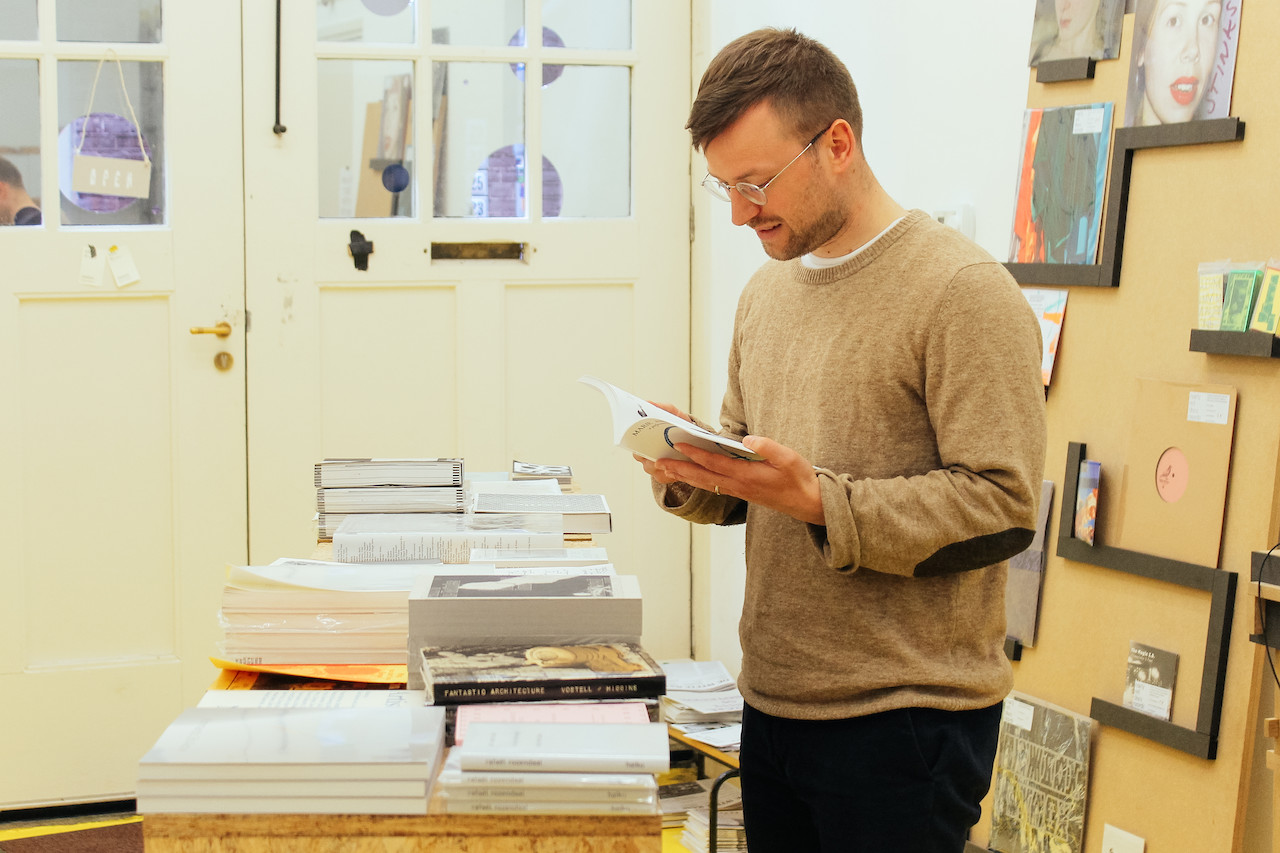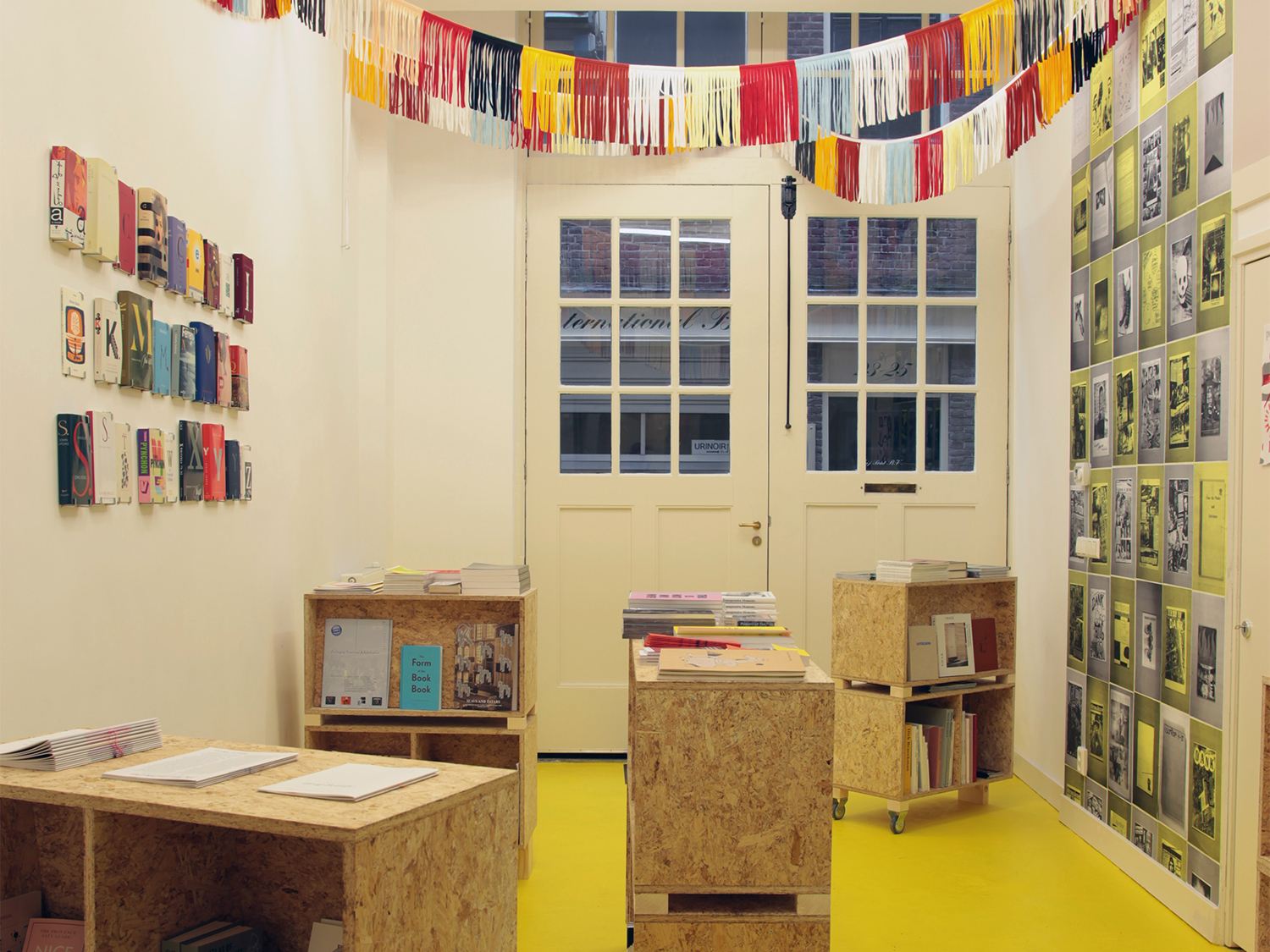A space between literature, experimental writing, and visual arts
Run by curator Pieter Verbeke and graphic designer Elisabeth Klement, San Serriffe is not only an art bookshop but also a destination. The Amsterdam-based initiative is according to its owners, a place where books are presented not as end products, but as the start for formats such as performances, talks, discussions or exhibitions.

Is there a typical San Serriffe customer – if yes, who are they?
We’re located in Amsterdam’s Red Light District, a very touristy area where thousands of tourists pass by our store every day. However, on a yearly basis we only sell a handful of books to random passersby since they’re interested in different goods than books. Unless they have a specific reason, Amsterdammers avoid this jungle most of the time except, for example, for the events that we organize almost on a weekly basis.
In general, we can say that San Serriffe’s visitors are well informed, critical, and come from all over the world. They’re often makers themselves: whether as artists, designers or writers, and lots of them are students.

How would you say that San Serriffe is positioned in the arts field and the bookshop scene in Amsterdam? What would you say your contribution is?
In Amsterdam, there’s a couple of great bookstores and antiquarians. Boekie Woekie is a legendary artists’ bookstore that has been going strong since the early 1980s. Soon after San Serriffe started, Buchhandlung Walther König opened a shop inside the Stedelijk Museum, offering a large selection of books on contemporary art and theory. And then there’s Athenaeum news centre, which offers a great selection of magazines as well as a good literature selection. A shop that had downsized when we started was the legendary graphic design bookstore Nijhof & Lee, which is now permanently closed.
We started San Serriffe in 2011, at a time when a series of severe subsidy cuts for art and culture took place in the Netherlands, which meant that some art spaces had to close or become smaller and that artists and designers were moving out of Amsterdam because of a lack of opportunities and income. At that time the Stedelijk Museum was closed for renovation, so the art and design field in Amsterdam was quite damaged. From the start, we wanted to host a diverse range of events around publishing culture and the financial structure of a shop would cover the rent of the space where these events took place. Nowadays we run our own program at San Serriffe, but we also very often work together with other initiatives. We frequently host book presentations with other (nomadic) art spaces in Amsterdam and The Netherlands such as If I Can’t Dance and Casco. We’ve also recently made a thematic book selection for a conference on precarious work conditions at the local art academy, the Sandberg Institute.

A book is a complex device that involves a lot of people and travels to many different places.

A bookshop can be said to be a place for the distribution of books, but arguably it can also play an important part in the arts’ ecosystem. San Serriffe, for example, also hosts events, launches, and debates – how do you see your contribution to the field of art and design?
We don’t only see ourselves as a shop, but also as a place where book culture is debated and where projects by artists and designers in book form are not presented as end products, but as the start for a performance, talk, discussion, exhibition or similar.
During our regular book launches, it’s sometimes amazing to see who’s present: the artist, the publisher, the designer, the editor, the distributor, the curator, the lithographer, the printer, the gallerist, and so on. A book is a complex device that involves a lot of people and travels to many different places. It’s interesting to see how everyone is a piece of this complex and fragile ecosystem.
Not all our events are related to a specific object, though. As an example, Elisabeth organizes a series called How To Show Up? at San Serriffe in collaboration with artist Gianmaria Andreetta, writer Annie Goodner, and curator Elisabeth Graham. Every other month a writer, artist, or designer with a strong writing component to their practice presents a new piece where the space of the bookstore is completely transformed for the evening. The evenings also function as a place to experiment with writing and to find out what it can do when it doesn’t have to fit in the format of a book.
When it comes to distribution outside of the walk-in customer, how large a part of your operation does this play?
In the beginning, we refused to have a webshop and we only announced our events through our website. We liked that people would have to visit our shop to see which books we were actually selling. But because we receive a lot of requests for books to be shipped abroad, we’ve started to develop a webshop which, even after 3 years, is still under construction.
We’re also asked very often to make a selection of books for exhibitions or symposia or participate in fairs, which is a great occasion to meet new publishers and customers.

In the field of arts and design publishing, the 2000s and early 2010s were dominated by discussions around self-publishing. What do you believe is the most pressing and contemporary discourse in the field of arts publishing today?
Our interest partially lies within a space between literature, experimental writing, and visual arts. We organized a great evening with the British poet Sophie Collins and Will Holder, a typographer who edits the magazine F.R. David and is a regular guest at San Serriffe, during the last How to Show Up? event on reading and writing within visual arts. We see a lot of young artists experimenting with words on the page who connect critical theory and work experimentally – it’s very exciting to see what happens with that.